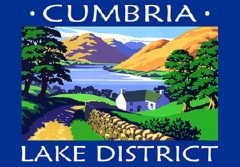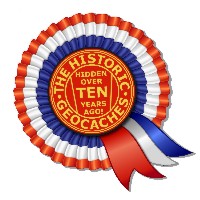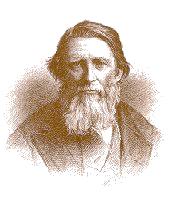Welcome to Cumbria and our stage of the Little Quest: a cache in every county of England! Note down the co-ordinates written on the log book of each LQ cache to enable you to discover the final location.
This cache site has been carefully chosen to give you a sample of what Cumbria has to offer. It sits on a hillock above the traditional village of Coniston, where most of the buildings are made from grey slate hewn from these very hills. From the cache site you will get a great view over the valley, lake and hills, with links to many aspects of this diverse county.
The short version: have a nice walk up to the cache on the small summit; take care and note the weather forecast; enjoy the view.

The longer version: The Victorians invented ‘mountaineering’ in Cumbria at Wasdale Head, and like millions of others since then you will need to don appropriate clothing and venture into the hills. It shouldn't be too much of a challenge though!
The adventure begins as you drive out of Coniston village up a seriously steep hill. Keep going until you reach the car park at the end of the tarmac (please close the gate). This is part of an old pack-horse road, Walna Scar, which climbs over the hills and into the Duddon valley; our route, however, goes north and follows an old mine road. Although there is tremendous natural beauty here, there are also significant marks of past and present industry.
 As you walk up the track you will probably pass an important feature of Cumbria – sheep. Herdwicks are the local pure breed which are well suited to survive on the high hills. The county took a long time to recover from the foot & mouth disaster in 2001 when thousands of sheep and cattle were culled. The sheep are primarily responsible for the neat, grass covered hills that make walking in the Lakes so pleasant.
As you walk up the track you will probably pass an important feature of Cumbria – sheep. Herdwicks are the local pure breed which are well suited to survive on the high hills. The county took a long time to recover from the foot & mouth disaster in 2001 when thousands of sheep and cattle were culled. The sheep are primarily responsible for the neat, grass covered hills that make walking in the Lakes so pleasant.
Reaching the col on the track you are joined by the main route up to Coniston Old Man, one of the most popular hills in the Lakes. Cumbria was home to Alfred Wainwright who played a significant role in popularising the hills through his hand-drawn guide books. He spent his life charting the lumps, bumps and hollows of this unique area of the UK.
At the col you get a marvelous view down into Copper Mines Valley - worked since Roman times and once the largest source of copper in the world. The white cottage was the mine manager's house and is now a youth hostel. The hills are riddled with shafts and caverns, extending over a thousand feet down into the roots of the mountains. The quarries nearest the lake are for slate, some still being worked today – they have very different coloured spoil heaps.
Elsewhere in the county, at different times, other materials have been mined. Iron ore, limestone and coppiced woodland gave the southern part, on the other side of the lake, its “Furness” tag, while on the west coast coal was important. Around Keswick was a strategically important source of graphite for gunpowder and pencils. The county still has active slate and limestone quarries, plus chemical, pharmaceutical and paper making industries.
From the col turn sharp right up the grass slope and follow the small path to the left of the knolls; this will bring you to the cache site below the summit of The Bell. From the top you have a grandstand seat for the array of the Coniston Fells rearing up to the NW and covering half the scene.
Looking S & SW you can see down to the coast, on a good day. From the monks who built Furness Abbey, to the Celts and Vikings who used the sea as their highways, to today's submarine makers, the off-shore wind farmers, and the gas field harvesters in Morecambe Bay, the sea has always played a large part in Cumbrian life.

Below our vantage point, lies the silver ribbon of Coniston. Most famous for Donald Campbell’s water speed records, which ultimately cost him his life. Campbell is the only person to have held both water and land speed records at the same time. In March 2001 his boat, Bluebird was raised from the lake and is being restored. Campbell is buried in the village church.

SE across the lake you can see a large cream house, Brantwood, home for many years to John Ruskin. He was one of the greatest figures of the Victorian age, poet, artist, critic, social revolutionary and conservationist. The county is famous for many other poets, artists and writers such as Wordsworth and Beatrix Potter. Rising behind Brantwood is part of Grisedale Forest, another major land use in the area.
One of the main reasons Cumbria is so diverse is that the geology varies significantly over quite a small area, leaading to a wide range of landscapes. The other side of the lake consists of marine sedementary rocks of the 'Windermere Group'. The high hills this side and in the centre of the Lakes are formed of 'Borrowdale Volcanic Group' rocks. Various rocks like limestone, old red sandstone, coal and others, occur in bands around this central volcanic area. The change between the two rock groups is very clearly illustrated here at Coniston.
The village below offers many delights including boat hire, a small ferry which enables linear walks along the lake, a steam yacht 'Gondola' for cruising the lake, plus the Ruskin Museum, which is a great place to find out more about the area. Outdoor shops, cafés and pubs provide plenty of opportunities for refreshment. The Black Bull has its own micro brewery.
Cumbria is a very diverse county with much more than just the hills as a place to re-create ourselves. We hope you enjoy your visit to our county during your Little Quest, or if you live here, it’s another chance to celebrate this unique corner of the world. Allow about 30-40 minutes to walk to the cache, less on the return.
For an excellent weather forecast specifically for mountain users see: Mountain Weather Information Service
For more info about the Little Quest series/challenge: Facebook Group and a statistics site: here